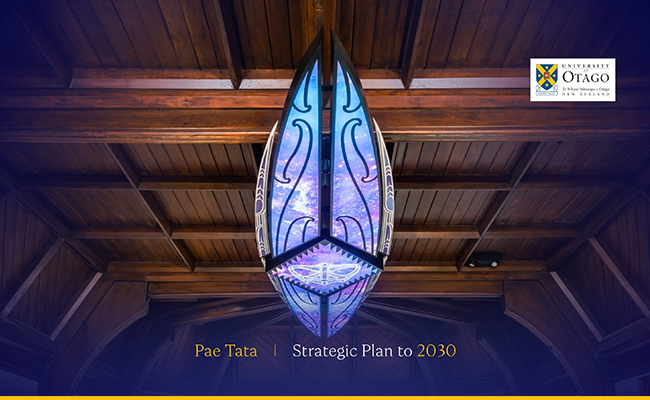
Pae Tata shapes the University's work over the coming years, outlining principles, priorities and success measures.
The University of Otago's goals for the next seven years, and how it will go about achieving them, have been outlined in its Strategic Plan to 2030.
Known as Pae Tata, the plan follows on from Vision 2040, the document outlining our strategic direction and aspirations for the future.
Acting Vice-Chancellor Professor Helen Nicholson presented Pae Tata to staff at a forum last week and a series of staff hui start on Tuesday, 4 July.
This new strategic document lays out the plan for the University's next seven years of operation, outlining principles, priorities, and success measures for the mid-term, across teaching, research, and operations.
“While Vision 2040 sets the goals of our pae tawhiti, our distant horizon, this strategic plan sets the goals of our pae tata, our near horizon,” she says.
“The high-level guidance will be used by University leaders to make decisions on strategic direction, ensuring we can continue to deliver high-quality teaching and research, and informing decision-making about what services we continue to offer.
“It articulates the case for change at Otago, in order to become a nationally and internationally competitive university, to meet student expectations, and to focus us on our strengths and on our place in the world.”
Staff hui
Eight hui, running over the next two weeks, will enable staff to gain greater understanding of the plan's goals and ask questions of University leaders.
Each hui has a different topic – research, digital, campus, teaching, global outreach, people and capability, and one each in Christchurch and Wellington. Details of each are available on the Pae Tata SharePoint site.
The plan
Produced by the University Council and Senior Leadership Team, along with international tertiary-specialist consultant Nous, the plan underpins the University's Te Tiriti partnership and its strategic frameworks for Māori, Pacific and Sustainability.
It contains key outcomes and actions across five areas, which will be implemented according to priority:
- Provide a compelling and viable educational offer that delivers excellent student outcomes and experiences.
- Organise and focus research and innovation efforts to deliver high-quality, impactful research.
- Support our people to achieve their best.
- Whakamana Te Tiriti o Waitangi - strengthen our capability, capacity, and culture to honour Te Tiriti o Waitangi.
- Achieve our ambition to become a more global and connected university.
Each of these domains are supported by three areas of focus which contain actions to ensure the University is contemporary, effective, efficient, and responsive.
In order to achieve this, she says the University must change the way it teaches to ensure it meets expectations and becomes sustainable; focus research effort to increase impact and enhance performance; become more globalised to enhance student experience, increase research collaboration, and empower the University to take its place in the Pacific and the world; change its financial situation to enable reinvestment in teaching, research and impact; and improve processes, structures, and systems to deliver efficient, effective and responsive services for staff and students.
“This is a time for the University to have courage, compassion, and carefully consider its choices,” Professor Nicholson says.